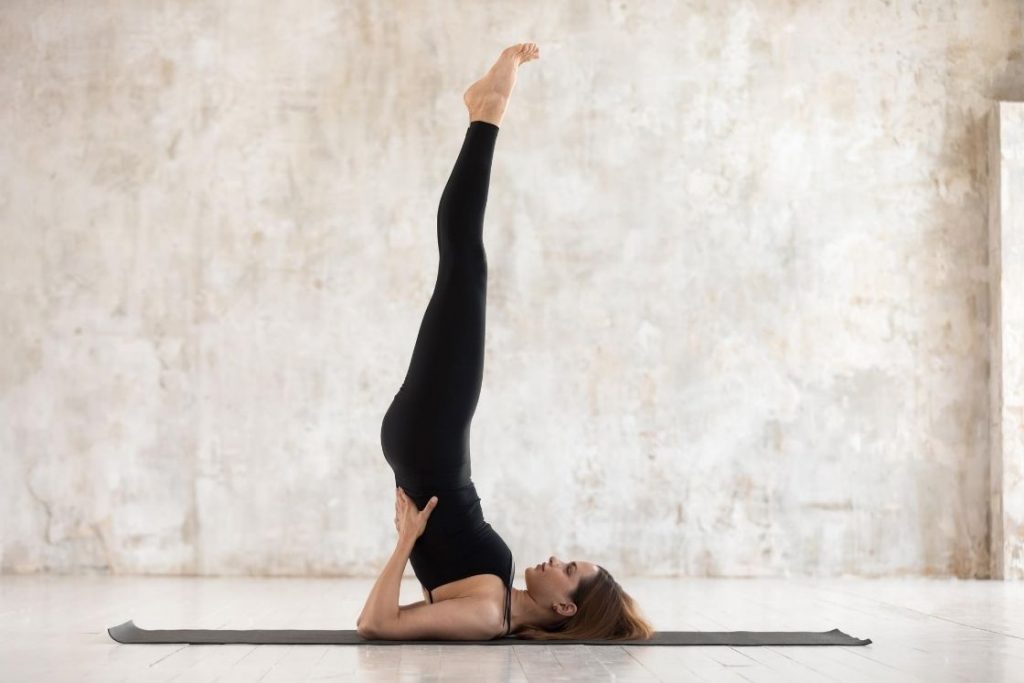
Sarvangasana yoga is one of the beginning poses of inverted pose series. On practicing it, you will feel the lightness of the body and a sense of relaxation in the mind.
The beauty and all the benefits of Sarvangasana lie in its inversion action, so let’s understand what does it mean and how it works.
Meaning
In Sanskrit, Sarvangasana is commonly called as Salamba Sarvangasana.
Salamba Sarvangasana is a combination of two words:
- Salamba (Sa – with + alamba – Support) means “with support”
- Sarvangasana (Sarva – all + anga – limb + asana – pose) means the “pose comprises all body limbs”.
In this pose, the back in an inverted position is supported by the hands & shoulder and all body limb gets benefits from it. So it’s called “Salamba Sarvangasana, Supported shoulder stand“.
Indeed, the shoulder is the primary limb in Sarvangasana on which the whole body rests. Besides shoulder, the neck is closely connected to it so when in this asana, pressure comes on shoulders it stimulates the thyroid gland present in the neck. As we know thyroid gland takes care of metabolism, growth, and development of all limbs so all body parts benefited in this asana simultaneously. This consideration makes it easy to understand how Sarvangasana benefited all body limbs – Because the shoulder supports the whole body in this position.
Shoulder stand – Mother of Asanas
Shoulder stand is quoted as “Mother of Asanas” by Guru Ji BKS Iyengar.
He says,
A mother strives for harmony and happiness in the home, so this asana strives for harmony and happiness in the human system.
Light on Yoga, BKS Iyengar
Also, it’s mentioned in his book, Sarvangasana should be master first before commencing in the practice of Sirsasana (headstand). It’s like a beginning class practice before we forwarded into the higher class. So, in comparison to Headstand which is called father or King of asanas, Sarvangasana plays a preparatory role into inversion poses therefore called mother or queen of asanas.
The modern version of Shoulder stand is popularised by T.krishnamacharya lineage but a similar pose called Viparita Karani is mentioned in 15th-century text Hatha Yoga Pradipika. It means this has been practiced from ancient times.
Apart from this, Sarvangasana is also documented in the 14th-century Shiv Samhita and 17th-century Gheranda Samhita.
Sarvangasana Practice Guide
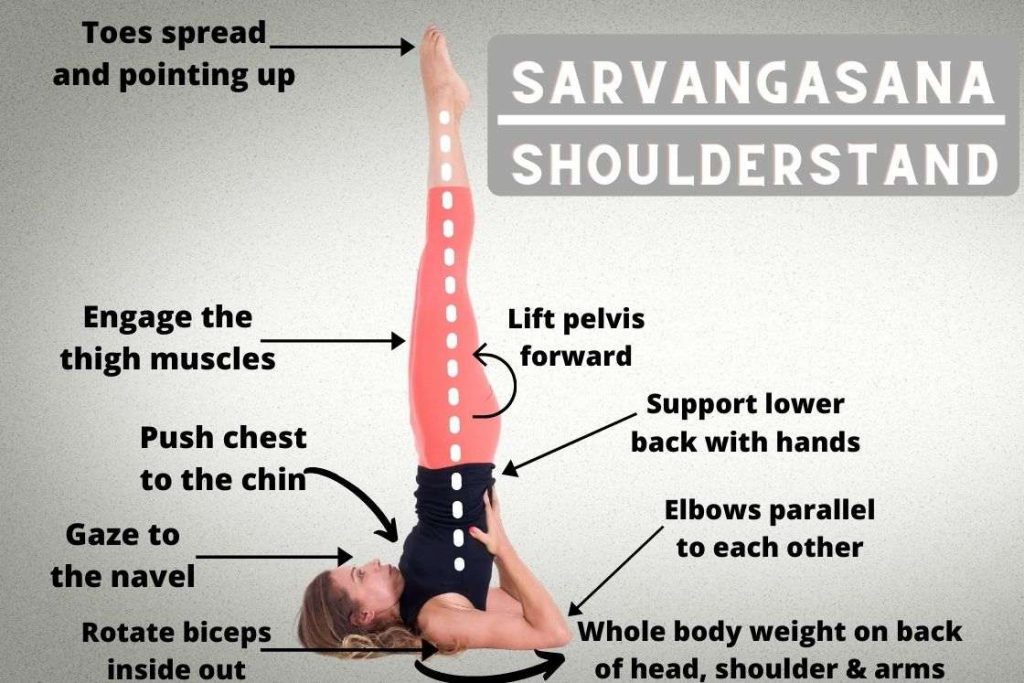
To begin the Salamba Sarvangasana practice easily and safely, go through the below points.
Precautions and Contraindications
- Avoid Sarvangasana during pregnancy and menstrual cycle. Practicing it reverses the blood flow which might do more harm than good in this condition.
- People having high blood pressure, a heart condition, glaucoma, or high myopia range should consult an expert.
- Practitioners with the condition of the sciatic nerve, injury in the spine or shoulder should avoid this asana.
- Don’t jerk while going into the pose – it may result in severe injury.
- Don’t practice any vigorous exercise before Sarvangasana as it may redirect excessive blood flow to the brain.
Preparatory Pose
- Bridge Pose (Sethu bandha Sarvangasana)
- Plow Pose (Halasana)
- Hero Pose (Virasana)
Sarvangasana Steps
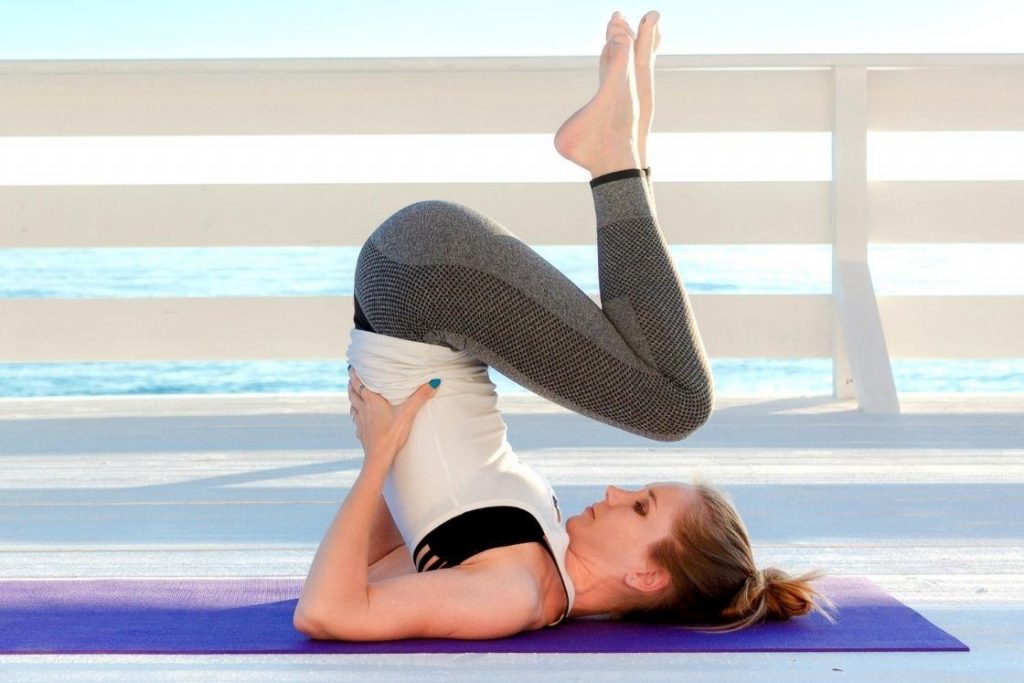
- Begin by lying flat on the mat. Stretch your legs from the tips of the toes to the back of the knees. Place hands next to hips on the mat – palms facing downward. Breath gently!
- Now with an exhalation, bend the knees and swirl up the legs towards the stomach. Let the front of your thighs touch the stomach and press it gently. Take a breath in.
- Exhale again, and raise your hips from the mat. Support the hips by bending the arms at the elbow. Rest the hips on hands. Breath in here.
- With further exhalation, slide your hands down and raise your trunk up until your chest reaches the chin. Now, support the middle of the back with your hands (both sides of the spine).
- Now check here – only the back of the head, neck, the shoulders, and back of the upper arms (the part between elbow and shoulder) should rest on the floor.
- Finally, open your bend legs and stretch them up. Toes should be pointing up.
- Breath gently and stabilize your body in a completely upward position.
The steps of advanced practitioner’s, however, comprises the complete plough pose (Halasana), where the final position is same as above.
Release
Hold Sarvangasana pose at least for 3 to 5 minutes. With practice, however, this period can be extended up to 15 minutes practice at the end of a yoga session.
A skilled practitioner can go beyond normal timing as long as it is comfortable. Do not exceed time in excitement or competence.
Beginners Tips
- To stabilize the body in Sarvangasana, bring your attention to the pelvis region. Usually, the body sways outward from the waist so the inward movement of the pelvis may help here.
- Remember, you have to move chest toward the chin not chin toward the chest while raising trunk in the inverted position. It will fully lengthen the spine.
- Avoid standing right after the finishing of Sarvangasana practice. One should lie flat or in Shavasana for few seconds before leaving.
- Make sure that shoulder supports the body weight. Avoid weight-bearing on the neck or cervical vertebrae as it is the most delicate vertebrae of the spine.
Check the modifications below to ease the practice of Sarvangasana for beginners.
Props and Modification
- If unable to flat your back of the head, then use a folded blanket underneath the neck. This will assist the neck in the posture.
- Practitioners who having difficulty in maintaining the posture can take the help of the wall to rest feet on it. Take the distance gap from the wall as per the height (Taller go wider and Shorter go narrower).
- One can raise one leg as in Ardha Sarvangasana and practice it before initiating Purna Sarvangasana practice.
- In case of elbow sway to the side, one can use a strap with the shoulder width and looped it around the forearms before practicing of Sarvangasana.
Follow Up Poses
- Corpse Pose (Shavasana)
- Fish pose (Matsyasana)
Sarvangasana Variations
Sarvangasana has the maximum number of Variations in poses. In Krishnamacharya’s book Yoga Rahasya there are 66 variations of Shoulder stand along with headstand.
Some most common variation are the following:
1. Setu Bandha Sarvangasana
It’s known as bridge pose. In this variation of Sarvangasana, the body comes down from inverted to backbend position. Or alternatively,
- Instead of swirling up the of legs after bending knees in the second step, keep feet place at hips distance.
- Now, raise the lower back and then upper back one by one.
- Support back with your hands.
2. Padma Sarvangasana
In this, legs come in padmasana after reaching the final position of Sarvangasana. It’s called Lotus shoulder stand. To do this,
- In the final position, place your left leg on the right thigh and right leg on left thigh.
- Maintain the basic Sarvangasana position.
3. Ardha Padma Sarvangasana
It’s the half lotus shoulder stand pose. To do this,
- From Sarvangasana, bend one leg and place it over the thigh of the opposite leg.
- Keep the opposite leg standing upright.
- Maintain basic Sarvangasana position.
4. Eka Pada Sarvangasana
It’s called One Legged Shoulder stand Pose. To do this,
- The hand should be on the floor and fingers interlocked to support the base pose Sarvangasana.
- Now, slowly bring your right foot down and touch the floor behind the head, hold here. Perform the same with another leg.
5. Parsvaika Pada Sarvangasana
Parsvaika i.e. Parsva + eka + pada means one leg side. In this variation, one leg brings a side to the floor (in line of the trunk) while another keeps standing as the base pose. It’s called Side One-Legged Shoulder
stand Pose.
6. Parsva sarvangasana
Parsva means side. This variation is done by giving the trunk a lateral twist from the base Sarvangasana pose. It’s called side shoulder stand pose.
Sarvangasana (Shoulder stand) Benefits
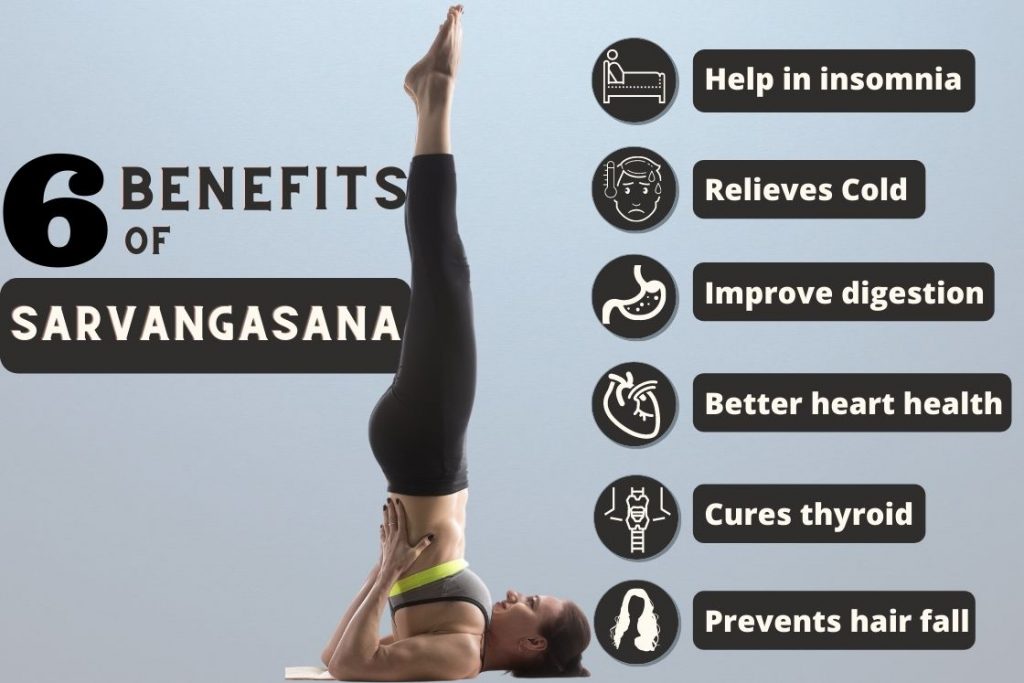
- Cures thyroid gland problems – Sarvangasana helps to exert pressure on the thyroid gland so increases the blood flow into it. A research study has shown Sarvangasana dispenses the need for medical treatment and maintain thyroid balance in normal individuals.
- Reduce hair fall – In Ayurvedic treatment one of the causes of hair fall has told Suppression of nutrients (Vegavidharana). Shoulder stand massages the scalp and supply nutrients to the hair. It makes the hair roots strong and prevents hair fall.
- Improve cardiovascular health – Because Sarvangasana is a head-down body-up pose, it increases the flow of oxygenated blood to the heart. In one study, various cardiac variables (heart rate, stroke volume, bp) were measured before and after practicing Sarvangasana. It has found, the overall working of the heart improves significantly from Sarvangasana practice.
- Increase flexibility – As the shoulder bears whole body weight in Shoulder stand, it strengthens them. Strong shoulder increases the range of motion of surrounding muscles which especially needed in sports like cricket and football.
- Balance throat chakra – Sarvangasana compresses the neck region, removes any knots causing an imbalance of Vishudhi (throat) chakra. A balanced throat chakra brings purity in your speech and relaxes tense neck muscles.
- Effective in diabetes – In diabetes mellitus patients, Sarvangasana practice along with specific pranayama can stimulate the endocrine part of the pancreas responsible for insulin secretion
- Aids in digestion – Changing the gravitational pull of abdominal organs in an inverted posture like Sarvangasana increases bowel movements and digestive system efficiency.
- Helpful in PMS & regaining fertility – Sarvangasana is proved to be an effective approach for women to lead a reproductively healthy lifestyle. This asana prevents the cyclical changes associated with ovulatory cycles or Premenstrual Syndrome (PMS). It also helps in regaining fertility in infertile women.

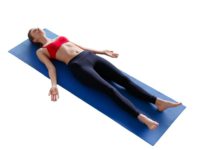
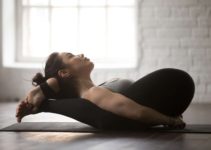

 2025, Feb 12 to 18
2025, Feb 12 to 18 Cultivate Inner Peace
Cultivate Inner Peace Practical Yogic Tools
Practical Yogic Tools
Namaste, More informative article given about each asanas practice. it helps a lot to know yoga benefits. Hari Om?